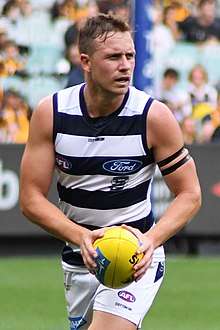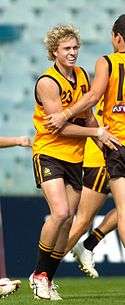Mitch Duncan
Mitchell James Duncan (born 10 June 1991) is an Australian rules footballer for the Geelong Football Club in the Australian Football League (AFL). A versatile player at 1.88 metres (6.2 ft) tall and weighing 87 kilograms (190 lb), Duncan is able to contribute in the forward line as well as the midfield.
| Mitch Duncan | |||
|---|---|---|---|
 Duncan playing for Geelong in April 2019 | |||
| Personal information | |||
| Full name | Mitchell James Duncan | ||
| Nickname(s) | Flid, Peepsie | ||
| Date of birth | 10 June 1991 | ||
| Place of birth | Perth, Western Australia | ||
| Original team(s) | East Perth (WAFL) | ||
| Draft |
28th overall, 2009 Geelong | ||
| Height | 188 cm (6 ft 2 in)[1] | ||
| Weight | 87 kg (192 lb) | ||
| Position(s) | Forward / Midfielder[2] | ||
| Club information | |||
| Current club | Geelong | ||
| Number | 22 | ||
| Playing career1 | |||
| Years | Club | Games (Goals) | |
| 2010– | Geelong | 207 (151) | |
|
1 Playing statistics correct to the end of 2019. | |||
| Career highlights | |||
| |||
| Sources: AFL Tables, AustralianFootball.com | |||
A standout junior footballer, Duncan entered top-level football early by signing for East Perth Football Club in the WAFL at the age of sixteen years. His accomplishments as a junior included winning a national championship with Western Australia, achieving All-Australian honours, selection for Australia in the International Rules Series, and being awarded an AIS-AFL Academy scholarship. Following a decorated junior career, Duncan was selected with Geelong's second pick, and twenty-eighth overall, in the 2009 AFL Draft.
Duncan made his AFL debut in 2010, and was nominated at the conclusion of the season for the AFLPA Best First Year Player Award.
Early life

Duncan was born in Perth, Western Australia and attended Carine Senior High School, before finishing his schooling years at Trinity College. Duncan is the son of former East Fremantle player Glen Rogers.[3] Playing school football alongside future AFL players Kane Lucas and Travis Colyer, Duncan helped Trinity College capture the Alcock Cup—Perth’s private school football tournament—in 2007.[4] Duncan progressed from school football to sign for East Perth Football Club at the age of sixteen years.[5] He achieved State honours for Western Australia in the under-16s AFL National Championships during 2007, captaining the state side and leading the team in total disposals. Duncan's promising junior performances were rewarded when he received a scholarship within the prestigious AIS-AFL Academy as part of the 2008 intake.[5] As an academy member, he subsequently participated in the squad tour to South Africa. The following season, Duncan achieved State honours for Western Australian as a bottom-aged player during the AFL National Championships.[5]
At the age of just 17, Duncan was selected to play senior football for East Perth at the beginning of the 2009 WAFL season.[5] However, a knee injury occurred in the first round of the season forced him to delay further appearances in the senior side.[5] Despite this setback, Duncan's performances for the East Perth under-18s team upon his return again saw him elevated to the senior team for the remainder of the season.
Duncan again received mid-year State honours for Western Australia in the AFL National Championships, and was named vice-captain of the squad.[1] His performances in the championships—during which he averaged 20 disposals at a team-high 75% efficiency, ranked third overall for total marks, and kicked eight goals[6]—earned him end-of-year All-Australian honours and helped Western Australia capture the 2009 national championship.[7]
Duncan's performances throughout the season saw him rewarded with an invite to the AFL Draft Camp, where he impressed recruiters by placing in the top 15 percent for the agility run, the top 12 per cent for the three-kilometre time trial and achieving a level of 14.1 in the beep test.[1]
AFL career
Duncan was drafted by the Geelong Football Club with their second selection, and was the twenty-eighth overall draft pick in the 2009 AFL Draft.[2]
2010 season
Duncan made his first appearance for the club during the 2010 NAB Cup, recording 14 disposals, four inside-50s, and two goals on debut.[8] He made his senior debut in the opening round of the 2010 AFL season, recording 10 disposals and 6 tackles against his childhood team Essendon.[9] During a round four fixture against Port Adelaide, Duncan recorded a career–high 20 disposals and 9 marks to help Geelong achieve a 95-point victory. In total, Duncan made 8 senior appearances during his debut season and finished the year ranked third amongst all first-year players in marks per game (5.4), sixth in goals per game (1.0), and sixth in goal assists per game (1.0).[9] His impressive performances throughout the year saw him nominated by his peers for the AFLPA Best First Year Award.[10]
2011 season
In round three against Port Adelaide he tallied 24 disposals and kicked two long-range goals and was rewarded with the round 3 nomination for the 2011 AFL Rising Star Award.[11]
Duncan's season continued strongly, playing in all but one game, including selections into Geelong's finals teams, and was also selected into the 2011 Grand Final Team as a substitute. He entered the match after forward James Podsiadly dislocated his shoulder. Duncan played an important role gathering 10 possessions and scoring a goal at the 27 minute mark of the third quarter. The Geelong Cats played hard contested football in the fourth quarter and kicked five goals and kept Collingwood goal-less, giving Geelong the 2011 Premiership and Duncan his first Premiership Medallion; the first won by a substitute – introduced in the AFL Rules in 2011.
Player profile
Duncan is regarded as a versatile utility player, capable of featuring as a forward or within the midfield.[12] As a lead-up forward, he is noted for his strong marking ability and his role in linking-up plays around the ground.[1] Kevin Sheehan has complimented Duncan on possessing "good foot skills ... on both sides of the body", while showing an "ability to read the game to advantage ... and make excellent decisions".[6]
Duncan's teammate Joel Corey has also acknowledged his maturity and professionalism, likening his game-day approach to that of Joel Selwood.[13]
In 2014, Duncan began writing a regular Saturday column in the sports section of the Geelong Advertiser. His column brings a fresh perspective to the Geelong Advertiser's sports coverage and is known for its hard hitting style
Statistics
- Statistics are correct to the end of the 2015 season.[14]
| G | Goals | B | Behinds | K | Kicks | H | Handballs | D | Disposals | M | Marks | T | Tackles |
| Season | Team | No. | Games | Totals | Averages (per game) | ||||||||||||
|---|---|---|---|---|---|---|---|---|---|---|---|---|---|---|---|---|---|
| G | B | K | H | D | M | T | G | B | K | H | D | M | T | ||||
| 2010 | Geelong | 22 | 8 | 8 | 6 | 67 | 42 | 109 | 43 | 18 | 1.0 | 0.8 | 8.4 | 5.3 | 13.6 | 5.4 | 2.3 |
| 2011 | Geelong | 22 | 21 | 22 | 10 | 192 | 165 | 357 | 100 | 49 | 1.0 | 0.5 | 9.1 | 7.9 | 17.0 | 4.8 | 2.3 |
| 2012 | Geelong | 22 | 22 | 20 | 12 | 262 | 138 | 400 | 122 | 68 | 0.9 | 0.5 | 11.9 | 6.3 | 18.2 | 5.5 | 3.1 |
| 2013 | Geelong | 22 | 25 | 14 | 16 | 310 | 216 | 526 | 161 | 72 | 0.6 | 0.6 | 12.4 | 8.6 | 21.0 | 6.4 | 2.9 |
| 2014 | Geelong | 22 | 24 | 23 | 10 | 302 | 245 | 547 | 151 | 78 | 1.0 | 0.4 | 12.6 | 10.2 | 22.8 | 6.3 | 3.3 |
| 2015 | Geelong | 22 | 11 | 8 | 3 | 105 | 130 | 235 | 62 | 26 | 0.7 | 0.3 | 9.6 | 11.8 | 21.4 | 5.6 | 2.4 |
| Career | 111 | 95 | 57 | 1238 | 936 | 2174 | 639 | 311 | 0.9 | 0.5 | 11.2 | 8.4 | 19.6 | 5.8 | 2.8 | ||
Notes
- AFL Bigpond Network, "28. Mitchell Duncan", Australian Football League & BigPond, 26 November 2009, accessed 2 December 2009
- "Mitch Duncan Player Profile bio" Archived 12 February 2010 at the Wayback Machine, Geelong Football Club & Bigpond, accessed 24 February 2010
- "Duncan lives the dream at the Cats". The West Australian. 7 April 2010. Retrieved 1 April 2013.
- Reed, D, "Duncan ticks first-year boxes" Archived 6 July 2011 at the Wayback Machine, Geelong Football Club & Bigpond, 8 July 2010, accessed 8 July 2010
- Duncan, M, "Draft Dream no.4: Mitch Duncan", The Age, 22 May 2009, accessed 25 February 2010
- Sheehan, K, "All the facts, figures and background for this year's AFL national draft prospects", Fox Sports, 20 November 2009, accessed 24 February 2010
- Phelan, J, "Up close: 2009 NAB AFL U18 All-Australian team", Australian Football League & Bigpond, 4 July 2009, accessed 24 February 2010
- Bigpond, "Star Cats to return soon", Bigpond News, 23 February 2010, accessed 24 February 2010
- "Mitch Duncan statistics", footywire.com, accessed 8 July 2010
- "Cats in line for AFLPA awards" Archived 30 December 2012 at Archive.today, Geelong Football Club & Bigpond, 2 September 2010, accessed 12 October 2010
- Holmesby, Luke (5 April 2011). "Shuey Rising". AFL.com.au. Retrieved 5 April 2011.
- Gullan, S, "Cats can kick it to Mitch or Duncan", The Herald Sun, 30 November 2009, accessed 2 December 2009
- Clark, J, "Mitch Duncan continues dream start to career", The Herald Sun, 10 April 2010
- http://afltables.com/afl/stats/players/M/Mitch_Duncan.html
External links
| Wikimedia Commons has media related to Mitch Duncan. |
- Mitch Duncan's profile on the official website of the Geelong Football Club
- Mitch Duncan's playing statistics from AFL Tables